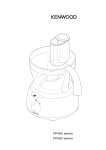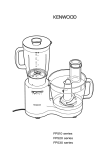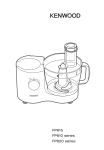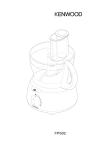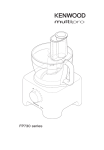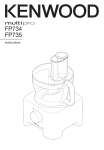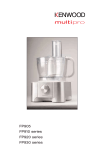Download 57818 FP770 English only A4
Transcript
FP770 series 햿 헀 a b 헁 c 헂 d 헃 e ● ● key before using your Kenwood appliance Read these instructions carefully and retain for future reference. Remove all packaging and any labels. processor safety ● ● ● ● ● ● ● ● ● ● ● ● ● ● ● ● ● ● ● ● ● ● ● ● ● The blades and plates are very sharp, handle with care. Always hold the knife blade by the drive shaft, away from the cutting edge, both when handling and cleaning. The Quad knife blades are extremely sharp. Please refer to the “using the attachments” section for instructions on safe handling. Always remove the knife blade before pouring contents from the bowl. Keep hands and utensils out of the processor bowl and liquidiser jug whilst connected to the power supply. Switch off and unplug: ● before fitting or removing parts ● after use ● before cleaning Note: Take care when handling the metal top of the drive shaft after prolonged continuous use as it may become hot. Never use your fingers to push food down the feed tube. Always use the pusher/s supplied. Do not put any part in the microwave. Before removing the lid from the bowl or liquidiser from the power unit:● switch off; ● wait until the attachment/blades have completely stopped. Allow all liquids to cool to room temperature before placing them in the liquidiser. This machine will be damaged and may cause injury if the interlock mechanism is subjected to excessive force. Never use an unauthorised attachment. Never leave the machine on unattended. Never use a damaged machine. Get it checked or repaired: see ‘service’. Never let the power unit, cord or plug get wet. Don’t let excess cord hang over the edge of a table or worktop or touch hot surfaces. Do not let infirm people use the appliance without supervision. Do not let children use or play with the appliance. Only use the appliance for its intended domestic use. Kenwood will not accept any liability if the appliance is subject to improper use, or failure to comply with these instructions. plate storage compartment power unit head release button on/off speed control pulse button swivel head bowl removable bowl drive shaft bowl lid seal lid feed tube pusher liquidiser filler cap lid lid seal top blade removable drive shaft/bottom blade jug additional attachments quad knife blade dough tool whipping tool thick slicing plate thin slicing plate coarse shredding plate fine shredding plate rasping plate fine chipper plate plate carrier centrifugal juicer attachment spatula before plugging in Make sure your electricity supply is the same as the one shown on the underside of your machine. to use your food processor 1 Fit the bowl to the power unit. Then fit the drive shaft to the bowl . 2 Fit an attachment over the drive shaft . ● Always fit the bowl and attachment onto the processor before adding ingredients. 3 Check the seal is fitted to the lid correctly (fit the grooved side of the seal into the lid) then fit the lid . 4 Turn the swivel head clockwise and press down until it clicks shut to lock securely . The processor will not operate if the head is not located correctly. 5 Switch on and select a speed. ● Use the pulse control for short burst. The pulse will operate for as long as the button is held down. ● The swivel head cannot be unlocked unless the speed control is in the OFF position. 6 Reverse the above procedure to remove the lid, attachment and bowl. To release the lid, hold one of the bowl handles whilst lifting the lid by the feed tube . Important – UK only The wires in the cord are coloured as follows: Blue = Neutral, Brown = Live. The appliance must be protected by a 13A approved (BS1362) fuse. Note: For non-rewireable plugs the fuse cover MUST be refitted when replacing the fuse. If the fuse cover is lost then the plug must not be used until a replacement can be obtained. The correct fuse cover is identified by colour and a replacement may be obtained from your Kenwood Authorised Repairer (see Service). If a non-rewireable plug is cut off it must be DESTROYED IMMEDIATELY. An electric shock hazard may arise if an unwanted non-rewireable plug is inadvertently inserted into a 13A socket outlet. This appliance complies with European Economic Community Directive 89/336/EEC. before using for the first time 1 Remove all packaging including the plastic blade covers from the knife blade. Take care the blades are very sharp. Blade covers can be used for when blades are stored if required. 2 Wash the parts see ‘care & cleaning’. ● ● 2 important Your processor is not suitable for crushing or grinding coffee beans, or converting granulated sugar to caster sugar. When adding almond essence or flavouring to mixtures avoid contact with the plastic as this may result in permanent marking. to use your liquidiser using the attachments 1 Fit the jug to the power unit. Then fit the drive shaft/bottom blade to the jug . 2 Fit the top blade to the drive shaft, taking care to rotate the top blade clockwise until it fits fully into place.. 3 Put your ingredients into the jug. 4 Check the seal is fitted to the lid correctly (fit the seal so the lipped edge of the seal faces outwards) then fit the lid . Fit the filler cap. 5 Turn the swivel head clockwise and press down until it clicks shut to lock securely . The liquidiser will not operate if the head is not located correctly. 6 Select MAX speed or use the pulse control. see chart for speed of each attachment. ● ● ● ● ● ● ● ● ● ● quad knife blade/ dough tool To fit the quad knife blade, first fit the drive shaft onto the metal pin in the bottom of the bowl. Then assemble the knife blades in the order shown taking care to rotate the top blade clockwise until it fits fully into place. Then fit the knife blade assembly onto the drive shaft inside the bowl. To remove, grip the assembly by the top of the drive shaft and remove the entire blade assembly from the bowl. To separate the quad knife blade, take extra care to hold each section by the plastic component and rotate the top blade anticlockwise until it becomes free from the bottom blade. hints When making mayonnaise, put all the ingredients, except the oil into the liquidiser. Then with the machine running, pour the oil down the hole in the lid. Thick mixtures, eg pates and dips, may need scraping down. If it’s difficult to process, add more liquid. When crushing ice, add 15mls (1tbsp) water to 6 ice cubes. Use the pulse control. The knife blade is the most versatile of all the attachments. The length of the processing time will determine the texture achieved. For coarser textures use the pulse control. Use the knife blade for cake and pastry making, chopping raw and cooked meat, vegetables, nuts, pate, dips, pureeing soups and to also make crumbs from biscuits and bread. important Allow all liquids to cool to room temperature before placing them in the liquidiser. To ensure the long life of your liquidiser, never run it for longer than 60 seconds. Switch off as soon as you’ve got the right consistency. Don’t process spices - they may damage the plastic. The machine won’t work if the liquidiser is fitted incorrectly. Don’t put dry ingredients into the liquidiser before switching on. If necessary, cut them into pieces; remove the filler cap; then with the machine running, drop them through one by one. Don’t use the liquidiser as a storage container. Keep it empty before and after use. Never blend more than 11⁄2 litres (2pts 12fl oz) - less for frothy liquids like milkshakes. Use the dough tool for yeasted mixes. ● ● ● ● ● ● choosing a speed for all functions tool/attachment function speed knife blade Cake making Rubbing fat into flour Adding water to combine pastry ingredients Chopping/pureeing/pates egg whites (best results approx. 4 minutes) cream (best results approx. 1 minute) yeasted mixes Firm food items such as carrots. Hard cheeses Softer items such as cucumbers, tomatoes Fruit and vegetables Lighter blending eg. batters, milkshakes Soups, sauces, pate and mayonnaise 1–9 5–9 whipping tool dough tool plates - slicing/ shredding/ chipping centrifugal juicer liquidiser ● ● ● ● ● ● maximum capacities Shortcrust pastry Flour wt Yeast dough Flour wt One Stage Cake Total wt Chopping meat Total wt Liquidiser Whipping Tool hints knife blade Cut food such as meat, bread, vegetables into cubes approximately 2cm/3/4in before processing. Biscuits should be broken into pieces and added down the feed tube whilst the machine is running. When making pastry use fat straight from the fridge cut into 2cm/3/4in.cubes. Take care not to over-process. dough tool Place the dry ingredients in the bowl and add the liquid down the feed tube whilst the machine is running. Process until a smooth elastic ball of dough is formed this will take 20 - 30 secs. Re-knead by hand only. Re-kneading in the bowl is not recommended as it may cause the processor to become unstable. whipping tool Use for light mixtures eg egg whites and cream. using the whipping tool 8–9 Max 6 6 5–9 3 8 1 Fit the bowl. 2 Fit the whipping tool to the drive shaft, making sure it is fully engaged. The whipping tool should locate at the very bottom of the drive shaft. 3 Fit the assembly into the bowl. 4 Add the ingredients. 5 Fit the lid and switch on. 1–3 Max ● ● Max hints Best results are obtained when the eggs are at room temperature. Ensure the bowl and whipping tool are clean and free from grease before operating. slicing/shredding discs 340g/12oz 500g/1lb 2oz 800g/1lb 11oz 800g/1lb 11oz 1.5litres/2pts 12fl.oz 4-6 egg whites slicing plates – thick , thin Use for slicing cheese, carrots, potatoes, cabbage, cucumber, courgettes, beetroot and onions. shredding plates – thick , thin Use for shredding cheese, carrots, potatoes and foods of a similar texture. rasping plate Grates Parmesan cheese and potatoes for German potato dumplings. chipper plate – fine Use to cut potatoes and firm ingredients for salads, garnishes, casseroles and stir fries (e.g. carrots, swede, courgette & cucumber). safety ● ● 3 Never remove the lid until the cutting plate has completely stopped. Handle the cutting plates with care – they are extremely sharp. to use the cutting plates service & customer care 1 Fit the bowl and drive shaft. 2 Select the desired plate and fit into the carrier with the cutting side uppermost. ● Locate one end of the plate under the rim and press the other end into position, it will only fit one way round. 3 Put the food into the feed tube. 4 Switch on and push down evenly with the pusher – never put your fingers in the feed tube. ● ● ● ● ● ● ● If the cord is damaged it must, for safety reasons, be replaced by Kenwood or an authorised Kenwood repairer. UK If you need help with: ● Using your machine ● Servicing or repairs (in or out of guarantee) call Kenwood customer care on 023 92392333. Have your model number ready - it’s on the underside of the processor. hints Use fresh ingredients Don’t cut food too small. Fill the width of the feed tube fairly full. This prevents the food from slipping sideways during processing. When using the chipper disc, place ingredients horizontally. When slicing or shredding: food placed upright comes out shorter than food placed horizontally. There will always be a small amount of waste on the plate or in the bowl after processing. Store the plates in the storage compartment . other countries Contact the shop where you brought the food processor. ● ● ● ● ● centrifugal juicer ● Use the centrifugal juice for making juice from firm fruit and vegetables. pusher attachment lid lid seal strainer inner bowl guarantee UK only If your food processor goes wrong within one year from the date you bought it, we will repair it (or replace it if necessary) free of charge provided: you have not misused, neglected, or damaged it; it has not been modified (unless by Kenwood); it is not second hand; it has not been used commercially; you have not fitted a plug incorrectly; and you supply your receipt to show when you bought it. This guarantee does not affect your statutory rights. recipes For the speeds of the attachments see page 3 1 Fit the liquidiser jug to the power unit. 2 Fit the juice extractor to the jug. 3 Check the seal is fitted securely (fit the seal so the lipped edge of the seal faces outwards) and fit the attachment lid . Do not use the Liquidiser lid . 4 Turn the swivel head clockwise and press down until it clicks shut to lock securely. The liquidiser will not operate if the head is not located correctly. 5 Cut the food into small pieces to fit the food tube. 6 Switch on and push down evenly with the pusher – never put your fingers in the feed tube. Process fully before adding more. 7 After adding the last piece, let the machine run for a further 10 seconds to extract all the juice from the strainer. ● ● ● ● ● ● shortcrust pastry 300g (12oz) plain flour 150g (6oz) mixture of lard and margarine cut into small pieces 2.5 mls (1⁄2 tsp) salt 45mls (3tbsp) cold water 1 Fit the knife blade and add the flour, salt and fat. Process for approximately 10 seconds or until the mixture looks like coarse breadcrumbs. 2 Then add the water down the feed tube on low speed until the mixture looks like it is about to stick together. 3 Turn out the mixture onto a worksurface and shape by hand. Use as required. ● For best results allow the pastry to rest before use. Place in a plastic bag or wrap in clingfilm and chill in the fridge for 20 minutes. important Do not use your centrifugal juicer if the strainer or inner bowl are damaged. If the processor vibrates, switch off and empty the strainer (The processor vibrates if the pulp becomes unevenly distributed). Process small amounts at a time (250g maximum) and empty the strainer and inner bowl regularly. Before processing remove stones and pips (eg pepper, melon, plum) and tough skins (eg melon, pineapple). You don’t need to peel or core apples and pears. hints Use firm, fresh fruit and vegetables. Citrus juice will be bitter and frothy because its peel and pith get processed too. winter warmer soup carrots, potatoes, onions: thirty 2cm (3⁄4”) cubes of each. bacon stock 150g (6oz) red lentils, washed. 375mls (3⁄4pint) vegetable stock one and a half 400g (14oz) tins chopped tomatoes. salt and pepper 300g (12oz) cooked bacon joint cut into 1cm (1⁄2”)cubes. 1 2 3 4 Put the carrots, potatoes and onions into the blender in that order. Add bacon stock up to 11⁄2 litre mark. Blend for no more than 5 secs. Pour into a saucepan. Then add the lentils, tomatoes, vegetables, stock and seasoning. 5 Bring to the boil, stirring constantly. Then simmer for about 1 hour, stirring regularly, until the ingredients are cooked. 6 Add the bacon cubes and heat through for 5- 10minutes. Serve immediately. care & cleaning ● ● ● ● Always switch off and unplug before cleaning. Handle the blades and cutting plates with care – they are extremely sharp. Some foods may discolour the plastic parts. This is perfectly normal and won’t harm the plastic or affect the flavour of your food. Rub with a cloth dipped in vegetable oil to remove the discolouration. power unit Wipe with a damp cloth, then dry. ● bowl/lid and attachments Wash by hand, then dry. Alternatively they can be washed on the top rack of your dishwasher (except for the centrifugal juicer attachment). A short low temperature program is recommended. ● lid seals Use the pointed end of the spatula to remove the lid seals. Wash the seals and ensure that the seals are fitted correctly before use. ● ● 4 lasagne white bread 300g (12oz) braising steak, cubed. 400g can of tomatoes 30mls (2tbsp) tomato puree 1 onion 5mls (1tsp) basil 100g (4oz) lasagne 200g (8oz) mozzarella cheese 15mls (1tbsp) oil salt and pepper 500g(1lb 2oz) strong white bread flour 5mls (1tsp) salt 15g(1⁄2oz) lard 15g (1⁄2oz) fresh yeast or 10mls(2tsp) dried yeast + 5mls (1tsp) caster sugar. 300mls (11fl oz) warm water, 100mls (31⁄2 fl oz) boiling water to 200mls (71⁄2 fl oz) cold water 1 Dried yeast (the type that needs reconstituting): Add the yeast and sugar to the warm water. Leave to stand for 5 - 10 minutes until frothy. Fresh yeast: crumble into the flour Other types of yeast: follow the manufacturer’s instructions. 2 Fit the dough tool or knife blade and add the flour (with fresh yeast if used), salt and lard. Process for a few seconds to evenly distribute the ingredients. 3 Then with the motor running quickly pour the liquid in a steady stream down the feed tube until the mixture forms an elastic soft dough. This will take about 30 seconds. 4 Remove the dough, place in a bowl, cover with an oiled piece of clingfilm or a plastic bag, and leave in a warm place for 45 - 60 minutes or until doubled in size. 5 Re-knead by hand for 2 - 3 minute. Re-kneading in the bowl is not recommended as it may cause the processor to become unstable. Shape into a loaf or 15 rolls and place on greased baking trays and leave until double in size. 6 Then bake in a pre-heated oven at 230°C/450°F/Gas mark 8 for 20 - 25 minutes for the loaf or 10 - 15 minutes for bread rolls. When ready they should sound hollow when tapped on the base. 1 Grate the cheese using the shredding disc. 2 Then separately chop the meat and onions with the knife blade. 3 Pre-heat the oil and fry the onions until softened, add the meat and fry until brown. 4 Then add the tomatoes, tomato puree and seasonings. 5 Stir well, cover and simmer gently for about 40minutes. 6 Cook the lasagne in plenty of salted boiling water until tender. Then drain well. 7 Place layers of meat, lasagne and cheese in a 1litre/2pint oven proof dish. Finish with a layer of cheese. 8 Bake at 190°C/375°F/Gas Mark 5 for 30minutes or until golden and bubbling. victoria sandwich 150g (6oz) soft margarine 150g (6oz) caster sugar 150g (6oz) self raising flour 5mls (1tsp) baking powder 3 eggs 15mls (1tbsp) warm water filling & decoration 3tbsp strawberry jam 150mls (1⁄4pt) double cream whipped (optional) 1tbsp icing sugar or caster sugar 1 Pre-heat the oven to 180°C/350°F/Gas mark 4 and grease two 18cm(7”) shallow cake tins. 2 Fit the knife blade. Place all the ingredients for the sponge in the bowl and process for 5 seconds. Using a spatula, scrape the mixture into the centre of the bowl and process for a further 5 seconds. 3 Pour the mixture into the prepared tins and bake for 20-25minutes or until firm to a light touch and coming away from the edges slightly. If you are unsure whether the cake is cooked insert a thin skewer in the centre and it should come out clean. Turn out onto a wire cooling rack. 4 When cool spread the jam and cream over one of the cakes, top with the other cake and sprinkle with the sugar. 5 Kenwood Limited, New Lane, Havant, Hampshire PO9 2NH, UK www.kenwoodworld.com 57818/1








